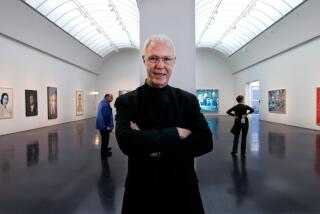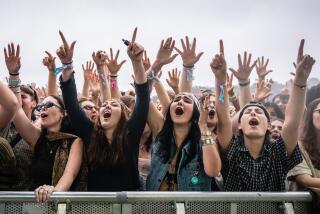Peter Sellars: Shopping for L.A. Down Under
TOWNSVILLE, Australia — Los Angeles Festival director Peter Sellars proved a gleeful presence during much of the fifth Festival of Pacific Arts, speeding from one venue to another like a butterfly collector about to pounce on a gorgeous new specimen.
Afterward, he paused to sort through what he called “the sheer smorgasbord of it,” definitively dismissing the hard-sell Tahitians (“progressive exhibitionism masquerading as high culture”), sharing insights about the elegance of the dancing from the islands of Wallis and Futuna (“Everything was supported on this cushion of secret energy”) and happily admitting that he had wept over the timeless rituals of aboriginals from the Tjurma Homeland (“one of the high points of a lifetime for me, as good as anything has ever gotten”).
It will surprise no one that Sellars was shopping for the 1990 Los Angeles Festival, but his conversations with Harvey Lichtenstein of the Brooklyn Academy of Music and Judy Mitoma of the UCLA World Arts and Cultures program, among other notables, raised questions about bold new alliances between major institutions.
Sellars acknowledged the partnership. “We’re not allowed to formally announce the BAM thing yet,” he cautioned, “but, needless to say--you were here--that’s in the wind.
“It will be a simultaneous festival on two coasts,” he revealed. “We’ll do it as a joint project because when you get all the money to bring one of these groups all the way to America, it makes sense to set up a couple of other gigs.”
The plan (confirmed by both BAM and UCLA) is for Sellars, Lichtenstein and Pebbles Wadsworth (UCLA Center for the Arts) to produce the Pacific component of the L.A. Festival, with Sellars and Mitoma as curators.
Sellars had previously announced that the 1990 Los Angeles Festival would have a Pacific orientation and, though he now plans to import some of the companies seen in Townsville, he also found concepts of presentation worth taking home.
“It was wonderful to watch Townsville warm to the festival,” he said. “A great strength of the previous Los Angeles festivals was that they were immaculately organized. That (the lack of organization) was the catastrophe here, but I know that’s what we do well. But now I really want to get that neighborhood feeling, that sense of grass-roots culture that made this festival so alive and so stimulating, that made you go home with your head spinning night after night.
“One of my main tasks now is to raise enough money so I can have this many free events,” he said. “That’s something that’s very important to me: to remove commerce from the artistic transaction. You felt that in the performance of these small villages, where nobody was making a profit on it, that art was truly intended as a way for the community to come together and share something. I hope we can reproduce that spirit of sharing, and the very intense warmth it generates, in Los Angeles.
“I also hope that we’ll do a lot of work that will respond to different ethnic groups that form the Los Angeles population. For example, most people think of the roots of black culture in Africa, but I think it will be interesting to present not just an Afro-American experience but black culture from the Pacific. So I think by the time we’re done we’re going to meet a lot of people’s points of interest or open up points of interest for people that they didn’t know they had.”
More to Read
The biggest entertainment stories
Get our big stories about Hollywood, film, television, music, arts, culture and more right in your inbox as soon as they publish.
You may occasionally receive promotional content from the Los Angeles Times.










